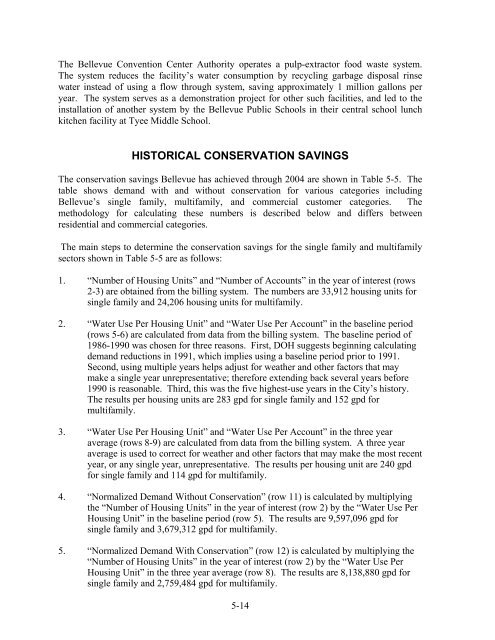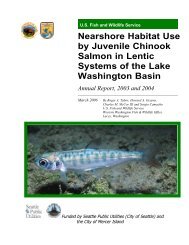2006 Water Comprehensive Plan - City of Bellevue
2006 Water Comprehensive Plan - City of Bellevue
2006 Water Comprehensive Plan - City of Bellevue
- No tags were found...
Create successful ePaper yourself
Turn your PDF publications into a flip-book with our unique Google optimized e-Paper software.
The <strong>Bellevue</strong> Convention Center Authority operates a pulp-extractor food waste system.The system reduces the facility’s water consumption by recycling garbage disposal rinsewater instead <strong>of</strong> using a flow through system, saving approximately 1 million gallons peryear. The system serves as a demonstration project for other such facilities, and led to theinstallation <strong>of</strong> another system by the <strong>Bellevue</strong> Public Schools in their central school lunchkitchen facility at Tyee Middle School.HISTORICAL CONSERVATION SAVINGSThe conservation savings <strong>Bellevue</strong> has achieved through 2004 are shown in Table 5-5. Thetable shows demand with and without conservation for various categories including<strong>Bellevue</strong>’s single family, multifamily, and commercial customer categories. Themethodology for calculating these numbers is described below and differs betweenresidential and commercial categories.The main steps to determine the conservation savings for the single family and multifamilysectors shown in Table 5-5 are as follows:1. “Number <strong>of</strong> Housing Units” and “Number <strong>of</strong> Accounts” in the year <strong>of</strong> interest (rows2-3) are obtained from the billing system. The numbers are 33,912 housing units forsingle family and 24,206 housing units for multifamily.2. “<strong>Water</strong> Use Per Housing Unit” and “<strong>Water</strong> Use Per Account” in the baseline period(rows 5-6) are calculated from data from the billing system. The baseline period <strong>of</strong>1986-1990 was chosen for three reasons. First, DOH suggests beginning calculatingdemand reductions in 1991, which implies using a baseline period prior to 1991.Second, using multiple years helps adjust for weather and other factors that maymake a single year unrepresentative; therefore extending back several years before1990 is reasonable. Third, this was the five highest-use years in the <strong>City</strong>’s history.The results per housing units are 283 gpd for single family and 152 gpd formultifamily.3. “<strong>Water</strong> Use Per Housing Unit” and “<strong>Water</strong> Use Per Account” in the three yearaverage (rows 8-9) are calculated from data from the billing system. A three yearaverage is used to correct for weather and other factors that may make the most recentyear, or any single year, unrepresentative. The results per housing unit are 240 gpdfor single family and 114 gpd for multifamily.4. “Normalized Demand Without Conservation” (row 11) is calculated by multiplyingthe “Number <strong>of</strong> Housing Units” in the year <strong>of</strong> interest (row 2) by the “<strong>Water</strong> Use PerHousing Unit” in the baseline period (row 5). The results are 9,597,096 gpd forsingle family and 3,679,312 gpd for multifamily.5. “Normalized Demand With Conservation” (row 12) is calculated by multiplying the“Number <strong>of</strong> Housing Units” in the year <strong>of</strong> interest (row 2) by the “<strong>Water</strong> Use PerHousing Unit” in the three year average (row 8). The results are 8,138,880 gpd forsingle family and 2,759,484 gpd for multifamily.5-14
















